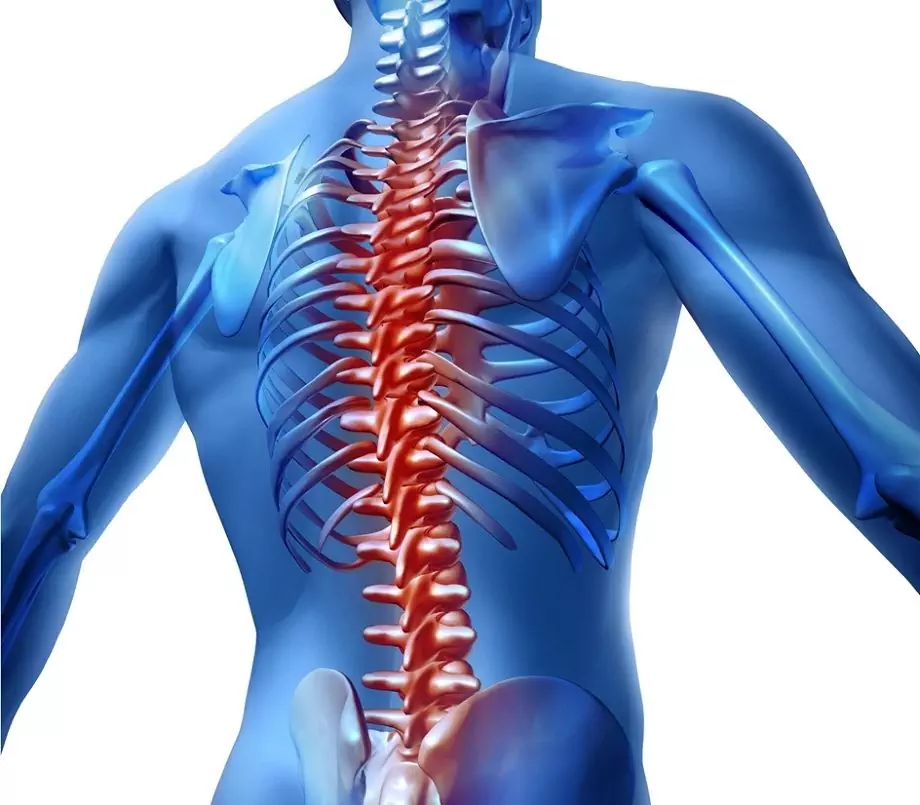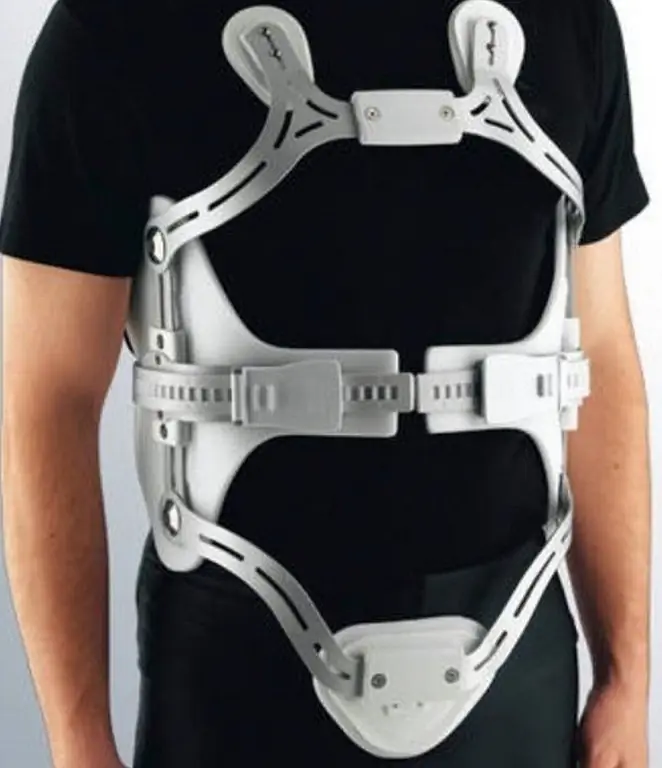- Author Rachel Wainwright [email protected].
- Public 2023-12-15 07:39.
- Last modified 2025-11-02 20:14.
Karipazim with a hernia of the spine
The content of the article:
-
Karipazim with a hernia of the spine: instructions for use
- Composition
- Pharmacotherapeutic group
- Pharmacokinetics
- Pharmacodynamics
- Indications for use
- Method of administration and dosage
- Side effects
- Contraindications
- Drug interactions
- Features:
- Overdose
- Storage conditions
- Reviews
- Vertebral hernia and approach to its treatment
- Video
Karipazim for hernia of the spine began to be used relatively recently (in the past it was used only in the treatment of severe burns).

Karipazim is not included in the official treatment for herniated discs.
Karipazim with a hernia of the spine: instructions for use
The use of Karipazim for spinal hernia has a number of features, the drug itself is considered relatively new. It is used in orthopedics, traumatology and neurosurgery. Taking into account the conducted clinical studies, the average effect of treatment with this drug is noted. Officially, it is not included in the hernia treatment regimen.
Composition
The drug is a white powder with a slightly yellowish tinge (sometimes available in compressed form - lyophilisate). Available in vials, one vial contains 350 PIUs of dried papaya juice. Approximate composition (the most important components are listed):
- papain (main active ingredient);
- chymopapaines A and B;
- peptidases;
- papaya lysozyme;
- a number of amino acids and carbohydrates;
- salts Na, K, Mg, Ca.
Also contains a number of auxiliary elements.
Pharmacotherapeutic group
The tool belongs to drugs intended for the treatment of wounds and ulcers and conditionally to the group of enzyme preparations. It is of vegetable origin.
Pharmacokinetics
The medicine is used more often for external use, therefore, it is not able to be absorbed and have a systemic effect on the body. Application in combination with physical methods of treatment (electrophoresis) leads to partial (less than 20%) penetration of the substance directly into the intervertebral space and gradual accumulation. The drug is capable of destroying necrotic tissue, its action is somewhat similar to the work of trypsin or chemotrypsin.
Pharmacodynamics
It is believed that the drug has proteolytic activity against only deformed protein structures and does not have an effect on all other protein molecules. This explains its use in the destruction of the intervertebral disc. Main effects:
- creates a depot in the affected spine;
- increases collagen production (provides partial replacement of the defect in the intervertebral segment);
- supports the production of chondroitin sulfates in the remaining areas of the disc, which contributes to the partial and gradual restoration of disc elasticity;
- reduces local edema and inflammation in tissues;
- somewhat enhances local blood flow (restoration of metabolism);
- stimulates the reaction of phagocytosis (destruction of damaged and non-functional cells).
In case of accumulation, an extremely small amount of the substance is further metabolized in the liver. The time of action, as well as the half-life, is extremely difficult to indicate due to the predominantly local use of the dosage form.
Indications for use
It is used for a small range of diseases:
- IIIA degree burns in order to accelerate the cleaning of the wound surface (often a person does not need a long course of treatment);
- for cleansing purulent wounds from necrotic tissues;
Experimentally - in the treatment of herniated intervertebral discs in the cervical and lumbar spine.
The drug is used along with other, more powerful agents (does not act as monotherapy).
Method of administration and dosage
The method of electrophoretic injection of Karipazim includes:
Treatment is strictly in the projection of the hernia (lumbar or cervical spine).
It takes courses of 20 procedures (2-3 courses are required). The procedure is repeated after 30-60 days.
The drug is administered only from a positively charged electrode.
The whole or half of the vial is diluted in 5-10 ml of saline (diluted immediately before use). Add 1-2 drops of Dimexide to the solution. A special sponge is moistened in the solution and applied to the positive electrode. Then it is placed on the affected area. A sponge soaked in 3-5 ml of 2.4% aminophylline solution (Euphyllin) is applied to the second negative electrode.
Electrode locations:
- Karipazim on the neck area (+) and Euphyllin on the lumbar area (-).
- Karipazim on the neck (+) and Euphyllin on the shoulder (-).
- Karipazim on the lumbar region (+) and Euphyllin on the back of the thigh (-).
- Karipazim on the lumbar region (+) and Euphyllin on the abdomen (-).
The drug helps the patient only with the correct placement of the electrodes. The duration of the procedures is 10-20 minutes. After the procedure, it is enough to cleanse the skin with a tampon dipped in saline solution.
The scheme of application for burns has its own specifics, it is not covered in this review.
Side effects
Side effects are relatively rare and include:
- allergic reactions (itching, urticaria);
- temperature rise (usually only at the local level).
The last presented side effect occurs only when used simultaneously with physical methods of exposure (electrophoresis, phonophoresis). This is due to the fact that alternating current of different frequency and intensity, penetrating through the electrodes, causes redistribution in the local blood flow (partial vasodilation).
Contraindications
Specific contraindications for use:
- intolerance to the components of the drug;
- local inflammatory tissue diseases;
- hernia in the sequestration phase (can cause a pronounced displacement of the vertebrae).
Drug interactions
The drug has no dangerous or clinically significant interactions, since it acts at the local level.
Features:
For a number of people, the drug requires a special approach to use:
- Cannot be used in children, since there is no clinical base and research on the effect of the drug on this population group (only from 18 years old).
- The drug is not recommended during pregnancy and lactation (there are no trials and studies proving the safety of use).
No other features were found.
It has no effect on the nervous system and is allowed to be received when driving.
Overdose
Overdose cases in patients have not been described, since the drug is used only for external treatment (despite the minimal cumulative effect in the area of the intervertebral disc). In case of a local allergic reaction, it is shown to rinse the affected area with water and apply hydrocortisone ointment.
Storage conditions
Stored for 2 years in a dry, dark place. Available only by prescription (prior consultation with a doctor is required).
Reviews
With a hernia of the spine, the reviews of Karipazim are mostly positive. Advantages of the drug:
- effective elimination of pain;
- slightly reduces the diameter of the hernia;
- relatively inexpensive in comparison with drugs of other groups.
The negative aspects include:
- difficulty in purchasing the drug (available in large pharmacies or only on order);
- absolute ineffectiveness against large-diameter hernias and with pronounced degenerative changes in the tissues.
Doctors have a twofold attitude towards this drug and prescribe it only as an auxiliary treatment, since it is difficult to establish the true effect on the course of the pathological process without taking into account the action of other drugs.
Vertebral hernia and approach to its treatment
An intervertebral hernia is a protrusion of elements of a deformed intervertebral disc into the extra-articular space. Most often, the fibrous ring protrudes anteriorly from the vertebral bodies. Pathology can form in any part of the spinal column, but more often occurs in the lumbar segment, since it has the maximum load.
The scheme of therapeutic measures for intervertebral hernia includes:
- drug therapy (NSAIDs, analgesics, chondroprotectors, muscle relaxants, vasodilators, lidocaine and novocaine blockades);
- Exercise therapy and massage;
- physiotherapy;
- surgical intervention (with large hernial protrusions and pronounced deformities).
Video
We offer for viewing a video on the topic of the article.

Anna Kozlova Medical journalist About the author
Education: Rostov State Medical University, specialty "General Medicine".
Found a mistake in the text? Select it and press Ctrl + Enter.






